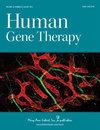rAAV2-hSyn-hRS1的玻璃体内输送可导致Rs1-KO小鼠视网膜神经节细胞特异性基因表达和视网膜改善。
IF 3.9
3区 医学
Q2 BIOTECHNOLOGY & APPLIED MICROBIOLOGY
引用次数: 0
摘要
X 连锁视网膜裂孔症(XLRS)是一种单基因隐性遗传性视网膜疾病,临床表现为视网膜裂孔和 b 波振幅与 a 波振幅不成比例地降低。目前还没有获得批准的治疗方法,而致病因子已被确定为视网膜裂孔素(RS1)。近十年来,基因疗法取得了长足的进步,给无法治愈的遗传疾病带来了希望。临床前研究表明,hRS1 基因增强疗法在小鼠模型中具有治疗效果。然而,临床结果并不令人满意,这可能归因于组装功能障碍和/或靶细胞受损。在预设研究中,我们使用了人突触素 1 基因启动子(hSyn)来控制 hRS1 的表达,该基因特异性地靶向视网膜神经节细胞。此外,我们的研究结果表明,在实验性 XLRS 小鼠模型中,单次玻璃体内注射 rAAV2-hSyn-hRS1 可使视网膜裂孔的结构恢复、视力改善和耐受性良好。简而言之,这项研究不仅支持了 rAAV2-hSyn-hRS1 载体在 XLRS 患者中的临床开发,而且证实了基于 rAAV 的基因疗法在遗传性视网膜疾病中的治疗潜力。本文章由计算机程序翻译,如有差异,请以英文原文为准。
Intravitreal delivery of rAAV2-hSyn-hRS1 results in Retinal Ganglion Cell-specific gene expression and retinal improvement in the Rs1-KO mouse.
X-linked retinoschisis (XLRS) is a monogenic recessive inherited retinal disease which clinically manifests retinal schisis cavities and disproportionate reduction of b-wave amplitude to the a-wave amplitude. Currently there are no approved treatments while the causal agent was identified as the retinoschisin (RS1). In the last decade, gene therapy has got great progress and given hopes to incurable genetic diseases. Preclinical studies demonstrated the treatment benefits of hRS1 gene augmentation therapy in the mouse models. However, clinical outcomes are dissatisfied which may attribute to the dysfunctional assembly and/or the impaired targeted cells. In the preset study, the human synapsin 1 gene promoter (hSyn) was used to control the expression of hRS1 which specifically targets to the retinal ganglion cells and our results confirmed the specific expression and functional assembly. Moreover, our results demonstrated that a single intravitreal injection of rAAV2-hSyn-hRS1 results in architectural restoration of retinal schisis cavities, improvement of vision and well tolerance in the experimental XLRS mouse model. In brief, this study not only supports the clinical development of the rAAV2-hSyn-hRS1 vector in XLRS patients, but also confirms the therapeutic potential of rAAV-based gene therapy in inherited retinal diseases.
求助全文
通过发布文献求助,成功后即可免费获取论文全文。
去求助
来源期刊

Human gene therapy
医学-生物工程与应用微生物
CiteScore
6.50
自引率
4.80%
发文量
131
审稿时长
4-8 weeks
期刊介绍:
Human Gene Therapy is the premier, multidisciplinary journal covering all aspects of gene therapy. The Journal publishes in-depth coverage of DNA, RNA, and cell therapies by delivering the latest breakthroughs in research and technologies. Human Gene Therapy provides a central forum for scientific and clinical information, including ethical, legal, regulatory, social, and commercial issues, which enables the advancement and progress of therapeutic procedures leading to improved patient outcomes, and ultimately, to curing diseases.
 求助内容:
求助内容: 应助结果提醒方式:
应助结果提醒方式:


